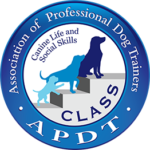CLASS Training
Level 1 module

Only the CLASS level 1 module is available here. The links to the other modules are emailed to you after successful completion of each module.
Resources
Please do not complete the position application until you have successfully completed all 5 modules.
Advanced training resources
Under construction
C.L.A.S.S. training terminology
Defined below is training terminology commonly used throughout the C.L.A.S.S. lesson plans
► Marker word: a short word that when consistently followed by a treat, tells the dog he did something you like; it predicts a reward; it bridges the gap between the behavior and the reward; the marker word should be said the instant the dog does what you want, and is always followed by some kind of reward. When training, you should use one marker word consistentiy.
Examples of marker words are “Yes”, “Good”, “Right.” (Don’t confuse marker words with rewards.
For instance, “Good Boy” is generally said as praise, which is a reward. Rewards always come after marking the behavior.
► Click: a noise made by a clicker that can replace the marker word; beneficial since it is more unique than a verbal word, but you must carry a clicker.
► Release word: a word that signals the dog can do something else, such as get up from a sit or go through a door. Typically, treats are not given AFTER saying the release word, because after the release, the dog is free to do what he wants to do, and you want to save the treats for when the dog is doing what you are training him to do.
Examples of release words are “Ok”, “Free”, “All Done”, ‘That’s all”, ‘Thank you”, and “Bingo.”
► Reward: anything the dog wants; some rewards are more important than others to a dog; examples of rewards are food (hot dog, chicken, kibble, cat treats), attention, walks, playing chewing, praise, and rewards depend on the individual dog’s preferences. We use food rewards for initial training procedures because food is high on the reward scale for dogs (since dogs need food to live), and food can be handled and delivered easily by the trainer in small portions.
► Praise: Praise is verbal approval or other indication of approval (e.9. gestures, facial expressions), and students are encouraged to generously connect verbally and relate in a positive manner with their dogs throughout each training session. Praise lncludes a cheerful or soothing tone of voice, a smile, or an enthusiastic “yay!” or “yes!” to cormmunicate to the dog the student is pleased with the performance and as a reward to the dog for performing the cued behavior.
► Luring: Luring is using food or other desirable object to entice a dog to do a particular behavior.
Luring can be:
• pretending to use food,
•tricking a dog into thinking you have food in your hand,
•pretending to pull a treat out of your pocket, and showing food to the dog.
Though hand signals can be derived frorn the action of a lure, hand signals are notconsidered lures. (Luring is not allowed during any C.L.A.S.S. evaluation.)
► Stress Signals: Some signs of excessive stress in dogs include: shutting down, tail tucked between legs, trembling, whining excessive barking, cowering, excessive chewing of the leash, pacing, excessive drooling, excessive panting, and trying to escape or hide. There are different intensities of these stress signs, and the student shall be aware of these signs and seek to protect the dog from extremely distressing situations.
lf a dog becomes excessively stressed during a training session, the student should pause to see if they can alleviate the stress, or the session should be ended.
► Cues: Cues are words or gestures that prompt a dog to perform a behavior. Cues can be verbal, that is, a spoken word or sound.
For example, the words “sit” and “down” may be verbal cues. Cues can also be visual, such as a hand signal, body movement. An example of a visual cue is holding your hand in a stop signal position toward your dog to cue the “stay” behavior. (The word “cue” is used instead of “command” throughout the C.L.A.S.S. program. A “cue” implies getting cooperation from a dog while the term “command” tends to connote a demand that a dog must do it, ‘or else.’


